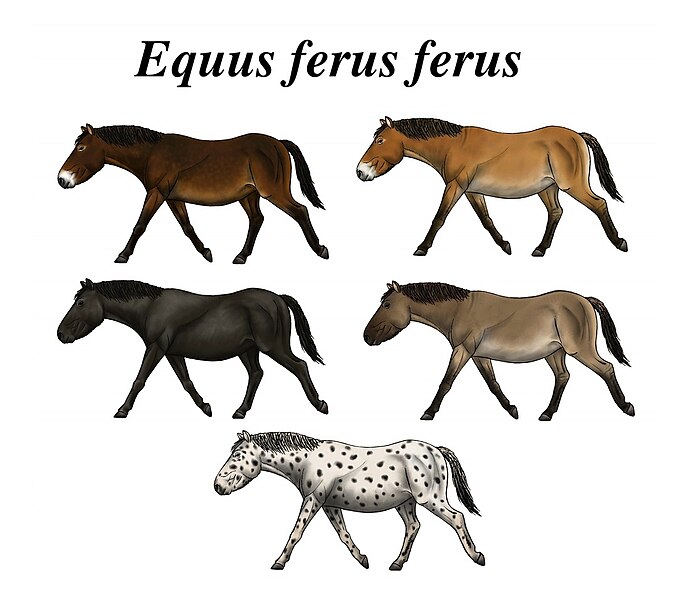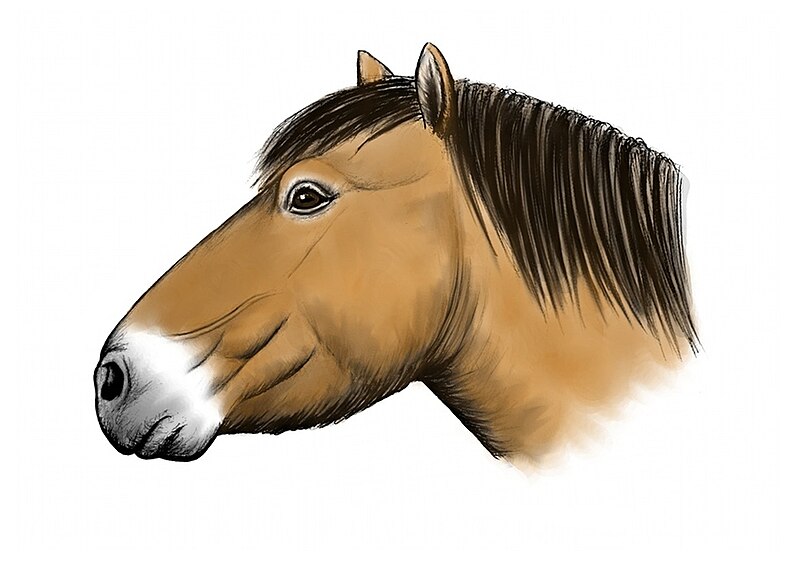Having
defined what we mean by “Tarpan”, we should have a look at the appearance of
the Holocene wild horses of western Eurasia, since there is some confusion as
well. Some believe the whole European wild horse population looked like wild Koniks based on a possibly biased interpretation of the literature and some references are based on Chinese whispers. The appearance of the wild horses of Europe and the Russian steppe is
well-documented by historic reports and coat colour genetics and shows that their appearance was quite variable, but there were some common and fixed traits.
This is a reconstruction I did for Wikipedia. My personal opinion is that the bay dun phenotype (top, left) perhaps was the most common colour morph. Bay is dominant over black and dun is dominant over non-dun, and historic references mention them frequently. Black dun horses apparently were no rare sight either, although genetics indicate that they were far less common than horses with bay genes [3]. Without having the dun factor identified in Holocene wild horse remains, its impossible to tell whether there were Tarpans completely lacking the dun factor or not [4]. I think it is probable, at least for more closed environments like forests and marshes (where a darker pelage might be more advantageous). Some authors, like Sue Baker, think the same [5]. Was there regional variation regarding the frequency of the different phenotypes? Perhaps, but according to my knowledge the data isn’t sufficient for us to draw conclusions yet. What about the striping on the legs and shoulders? It’s quite possible that a number of wild horses displayed a certain degree of striping since many dun coloured horses do and some historic references, like C. H. Smith, mention striped legs in wild horses. Stripes are not actually caused by the dun factor, but it makes them more prominent because the rest of the coat has a lighter colour.
First of
all, let’s see why I think that those historic accounts do in fact refer to
genuine wild horses (in most cases). To get a good idea
what the animals people described actually looked like, it is best to go as
much as “ad fontes” as possible to avoid Chinese whispers. That means: do not use
sources that are based on other sources that are themselves based on other sources and so
on (that maybe even don’t refer to the actual historic references), but try to
find out who gave those contemporaneous reports and what he wrote. Such
references include Albertus Magnus, Belsazar Haquet, Kajetan Kozmian, Peter
Pallas, Charles Hamilton Smith, Samuel Gottlieb Gmelin and others [1]. They all
describe horses with features very likely for pre-domestic wild horses, such as
a homogenous small stocky built, large thick head, small eyes, short ears, a
short frizzy mane, dark eel stripe, and dark legs (sometimes striped). The coat
colours most commonly described are tan or creamish, mouse-coloured and brown. One
source (Gmelin) mentions that the belly was coloured lightly. The behaviour was
described as very shy, intractable and untameable, defending themselves harshly
against predators and killing concurring domestic stallions. In my opinion,
this makes it very probable that the descriptions (which cover a period from
the 12th to the 19th century) describe genuine wild horses [1,2]. Those
references indicate that during the 18th and 19th century, there was increasing
domestic influence in the late Eastern European herds, such as domestic mares
included in wild herds, whitish animals, lightly coloured legs, grays (not
mouse dun) and so on [1]. So my conclusion is that genuine wild horses existed
until the end of the 19th century, but the few remaining populations got more
and more mixed with domestic horses towards the very end of their existence.
Historic references match
genetic information which tell us that 3 colour genes were present in
Holocene European wild horses: bay, black and leopard-spotted [3,4]. Considering
that the dun factor likely was present as well (because it is found in all
other extant wild equines), Tarpans might have displayed 5 possible colour
morphs:
Bay: A colour that we find in many horse breeds.
Bay dun: This combination
is the colour we see in Przewalski’s horses and other wild equines. Reports of
tan or yellowish-brown wild horses (like C. H. Smith) most likely refer to this
colour.
Black: Black is found in some primitive ponies such as the Fell Pony or the Garrano. C. H. Smith
mentions a black wild horse in Eastern Europe that may have been a feral horse.
Black dun: Also called
mouse-dun or Grullo. Its expressions vary between a very brownish mouse colour
and a light grayish colour. Some primitive horse breeds have a Grullo coat,
such as the Konik.
Leopard spotted: A white
base colour with black spots. Looks similar to the pelage of a Dalmatian dog
and nothing like a leopard. Why isn’t called Dalmatian-spotted instead? I
really don’t know.
Except the latter, all these
phenotypes are mentioned in at least some historic reports. I don’t know of any
source mentioning leopard-spotted wild horses, but quite possibly such animals
would have been mistaken for feral or hybrid horses by people who witnessed
them. Another colour trait that is possible for the Tarpan is the so-called pangare,
which is characterized by a light colour of the belly and around the mouth
(mealy mouth). Many bay or bay dun horses have it, as much as all living wild
equines. And, not to forget, some historic references describe a lightly
coloured belly in the Tarpan. So the pangare trait is likely to be found in
some Tarpans (note that black and black dun horses never display a mealy
mouth).
So, putting everything
together, Equus ferus ferus in all
its variability might have looked like this:
 |
| Reconstruction of the Tarpan using historic and genetic information, showing the five possible colour morphs |
This is a reconstruction I did for Wikipedia. My personal opinion is that the bay dun phenotype (top, left) perhaps was the most common colour morph. Bay is dominant over black and dun is dominant over non-dun, and historic references mention them frequently. Black dun horses apparently were no rare sight either, although genetics indicate that they were far less common than horses with bay genes [3]. Without having the dun factor identified in Holocene wild horse remains, its impossible to tell whether there were Tarpans completely lacking the dun factor or not [4]. I think it is probable, at least for more closed environments like forests and marshes (where a darker pelage might be more advantageous). Some authors, like Sue Baker, think the same [5]. Was there regional variation regarding the frequency of the different phenotypes? Perhaps, but according to my knowledge the data isn’t sufficient for us to draw conclusions yet. What about the striping on the legs and shoulders? It’s quite possible that a number of wild horses displayed a certain degree of striping since many dun coloured horses do and some historic references, like C. H. Smith, mention striped legs in wild horses. Stripes are not actually caused by the dun factor, but it makes them more prominent because the rest of the coat has a lighter colour.
You might wonder why I
portrayed those wild horses with a falling mane here. Well, there are no
historic references that I am aware that mention upright manes in the Tarpan.
“Short and frizzly” (some readers maybe only took note of “short”), as Tarpan
manes are described in a lot of historic accounts, does not necessarily imply
upright manes. Furthermore, there are frozen mummies of Siberian wild horses
from the Pleistocene that display long falling manes [5]. Therefore falling
manes are not a domestication-induced feature as it was believed. Apparently
such a feature is advantageous in regions with a lot of rainfall, as it diverts water from the neck and head, as much as a bushy tail [5]. Under this
assumption, the fact that the Przewalski’s Horse and all wild asses have an
erect mane and a tail showing either just a tuft at the tip or short proximal
hair just seems logical.
The head of the Tarpan was
rather different from that of domestic horses and resembled that of other wild
horses (living and extinct). According to my knowledge, only few skeletal
material of the Tarpan is known, and some alleged Tarpan specimen may actually
be feral horses. But historic references tell us something about the appearance
of the head of the European wild horses. As I mentioned above, numerous sources
say the head was large and thick with a robust lower jaw [1]. The Tarpan
apparently had a “beard” under the jaw like living horses that grow a thick
winter coat. Apparently the eyes were small [1,2]. Like all horses adapted to
harsh conditions, the Tarpan likely had fleshy ridges above the eyes – as seen
in Przewalski’s horses or Exmoor ponies (and numerous other robust ponies) –
that protect the eyes from rain, snow or dust [5].
Down below
you see another reconstruction I did for Wikipedia, a head of Equus ferus
lambei* that is based directly on a skull of a specimen. A Tarpan’s skull
perhaps was not very different.
 |
| Reconstruction of the head of Equus ferus lambei, a pleistocene wild horse |
* Mitochondrial DNA suggests that Equus lambei and Equus ferus
are conspecific according to an essay by J.F. Kirkpatrick and P. M. Fazio in
2005 [6].
In essence
it seems that the European wild horse had different colour morphs but a
homogenous stocky build similar to the Przewalski’s horse and primitive ponies.
Having had a look at how the Tarpan probably looked and behaved like, we should
go into the subject of Tarpan-like horse breeds in a following post.
Literature
[1] Tadeusz Jezierski, Zbigniew Jaworski: Das
Polnische Konik. 2008.
[2] Smith, Charles Hamilton: The
Natural history of Horses, with Memoir of Gesner. (1814/1866)
[3] Pruvost et
al.: Genotypes of predomestic horses match phenotypes painted in
paleolithic works of cave art. 2011
[4] Ludwig et
al.: Coat color variation at the beginning of horse domestication. 2009.
[5] Baker,
Sue: Exmoor Ponies: Survival of the Fittest – A natural history. 2008.
[6] Kirkpatrik,
Jay F.; Fazio, Patricia M.: Wild horses as Native North American Wildlife. 2005

Interesting phenotypes occurring amongst usual mixture of feral horse population - here in feral horses of Livno (Herzegovina):
ReplyDeletehttp://www.youtube.com/watch?v=gi_SN18Gmzw
Jump right at 4:18 min of video! It is (is it?) a subadult specimen, so it might still lose some of it's primitive characteristics. Right?
(I think that the gray and the white ones are the old ones - black to gray to white, with age)
Best regards!
Good blog!
Hi, thank you for your comment! These feral horses are really interesting, and some seem to have a correct wild-type colour (if the correct colour gene is present, I don't think this changes during ontogeny). It's always good to see that there are still hardy, feral horses like these living freely on our continent.
Delete